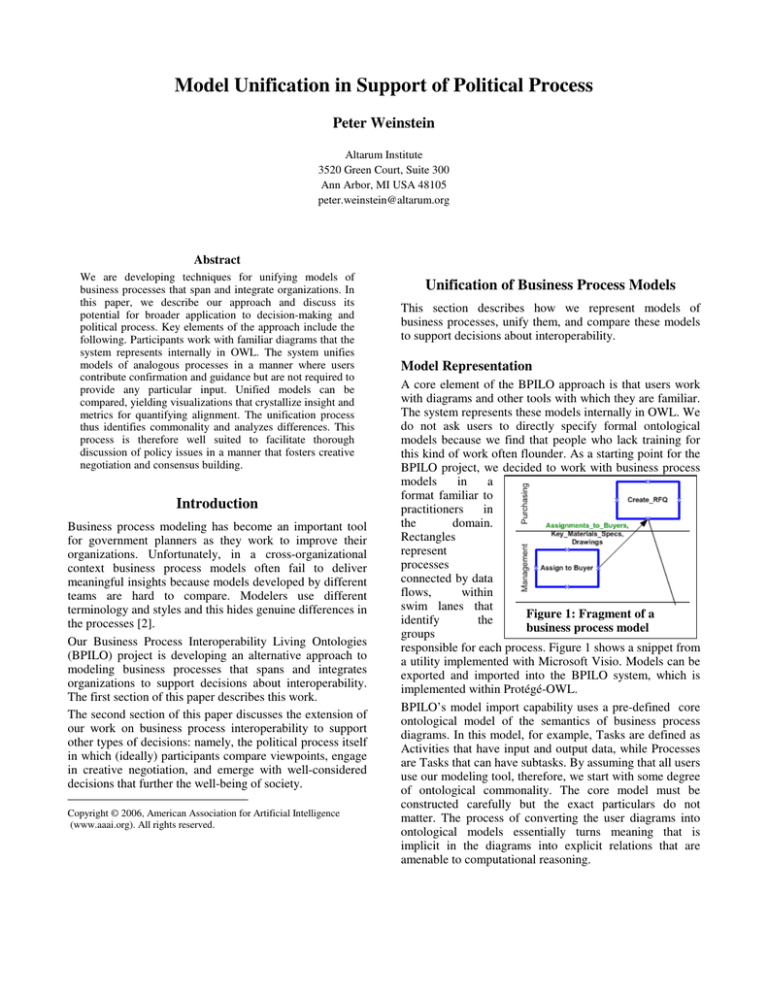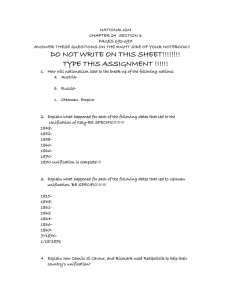
Model Unification in Support of Political Process
Peter Weinstein
Altarum Institute
3520 Green Court, Suite 300
Ann Arbor, MI USA 48105
peter.weinstein@altarum.org
Abstract
We are developing techniques for unifying models of
business processes that span and integrate organizations. In
this paper, we describe our approach and discuss its
potential for broader application to decision-making and
political process. Key elements of the approach include the
following. Participants work with familiar diagrams that the
system represents internally in OWL. The system unifies
models of analogous processes in a manner where users
contribute confirmation and guidance but are not required to
provide any particular input. Unified models can be
compared, yielding visualizations that crystallize insight and
metrics for quantifying alignment. The unification process
thus identifies commonality and analyzes differences. This
process is therefore well suited to facilitate thorough
discussion of policy issues in a manner that fosters creative
negotiation and consensus building.
Introduction
Business process modeling has become an important tool
for government planners as they work to improve their
organizations. Unfortunately, in a cross-organizational
context business process models often fail to deliver
meaningful insights because models developed by different
teams are hard to compare. Modelers use different
terminology and styles and this hides genuine differences in
the processes [2].
Our Business Process Interoperability Living Ontologies
(BPILO) project is developing an alternative approach to
modeling business processes that spans and integrates
organizations to support decisions about interoperability.
The first section of this paper describes this work.
The second section of this paper discusses the extension of
our work on business process interoperability to support
other types of decisions: namely, the political process itself
in which (ideally) participants compare viewpoints, engage
in creative negotiation, and emerge with well-considered
decisions that further the well-being of society.
Copyright © 2006, American Association for Artificial Intelligence
(www.aaai.org). All rights reserved.
Unification of Business Process Models
This section describes how we represent models of
business processes, unify them, and compare these models
to support decisions about interoperability.
Model Representation
A core element of the BPILO approach is that users work
with diagrams and other tools with which they are familiar.
The system represents these models internally in OWL. We
do not ask users to directly specify formal ontological
models because we find that people who lack training for
this kind of work often flounder. As a starting point for the
BPILO project, we decided to work with business process
models
in
a
format familiar to
practitioners
in
the
domain.
Rectangles
represent
processes
connected by data
flows,
within
swim lanes that
Figure 1: Fragment of a
identify
the
business process model
groups
responsible for each process. Figure 1 shows a snippet from
a utility implemented with Microsoft Visio. Models can be
exported and imported into the BPILO system, which is
implemented within Protégé-OWL.
BPILO’s model import capability uses a pre-defined core
ontological model of the semantics of business process
diagrams. In this model, for example, Tasks are defined as
Activities that have input and output data, while Processes
are Tasks that can have subtasks. By assuming that all users
use our modeling tool, therefore, we start with some degree
of ontological commonality. The core model must be
constructed carefully but the exact particulars do not
matter. The process of converting the user diagrams into
ontological models essentially turns meaning that is
implicit in the diagrams into explicit relations that are
amenable to computational reasoning.
Model Unification
We call models that are freshly imported into BPILO
original models. Original models contain heterogeneous
terminology – such that word meanings across models are
inconsistent, redundant, or more generally, overlapping in
ways that can be subtle and difficult to reveal. More
precisely, original models have two layers as illustrated in
Figure 2, where heterogeneous organization-specific
concepts inherit some properties from core concepts that
are shared (blue layers are shared, the red is not).
Core
Core
Generic
Organization Specific
Organization Specific
Original Models
Unified Model
Figure 2: From original models to unified models
Model unification converts original models to unified
models by creating a shared middle layer of generic
concepts from which organization-specific concepts inherit.
In the unified models, properties associated with
organization-specific concepts represent differences, while
properties inherited from the generic layer represent
similarities.
We implement model unification with an algorithm in the
style of swarm intelligence, inspired by social insects such
as ants and wasps, where organization emerges from simple
local interactions [3]. Our strategy is to design agents that
play roles defined by their associated roles in the unified
models. For example, the role of a generic concept is to
find the specific concepts that are best matched so as to
inherit as much as possible from the generic concept. The
swarming unification algorithm has three concurrent
processes involving generalization, aggregation, and rewriting of organization-specific terms. So far we have
implemented generalization, which matches concepts from
original models to create generic concepts.
We describe the generalization algorithm with an analogy
to the game of musical chairs. This is because only one
concept from each original model is allowed into a match.
For example, in Figure 3 the C:Prepare_RFQ concept
(from organization C) has asked to move into the match
defined by the generic concept G:Create_RFQ. This
involves kicking the C:Create_PO concept out of that
match.
The Match Agents in the generalization process base their
decisions on two kinds of input. We estimate lexical
association using the Semantic Lexicon tool from Fair
Isaac [1]. These estimates are based on word co-occurrence
in a corpus of documents describing business processes.
We also estimate structural compatibility: organizationspecific concepts are considered more similar if in the
original models they are related to concepts that are also
matched in the generalization process. Structural relations
are also used to accumulate suggestions to agents regarding
which matches to join. There is therefore a positive
feedback effect, as is typical of swarm intelligence
algorithms, where structural isomorphism encourages
further matches that express that isomorphism.
G:Create RFQ
G:Vendor Bid
A:Vendor Bid
A:Generate
eReq
B:Create PO
B:Prepare RFQ
C:Create RFQ
Figure 3: Concept matching as musical chairs
One of the benefits of swarming is that these algorithms
tend to adapt gracefully to runtime change in the problem.
This supports a style of user interaction that is anytime and
anywhere. Unification proceeds automatically, with
modelers contributing guidance and confirmation. The
system exposes its processes to users and invites advice,
rather than waiting for user inputs that may be difficult to
provide.
Model Comparison
The motivating goal of model unification is to support
model comparison. This can be achieved with graph
matching algorithms that may or may not be swarming in
nature [4]. Figure 4 shows a visualization of a comparison
of two processes, where one process is drawn in blue,
another in green, and the two diagrams are overlaid (this
figure is best viewed in color). Aspects of the concept
definitions that are modeled in the generic layer are shown
in pink. The pink therefore conveys similarity, while blue
and green are differences.
Each match and overall comparisons are quantified with a
metric that describes the degree of commonality (based on
a weighted combination of lexical association and
structural isomorphism). In any pragmatic context,
however, some differences are more important than others.
Therefore, we anticipate developing a variety of domainspecific metrics that reflect the objectives of analysis in
particular situations.
Figure 4: Fragment of a process comparison
visualization
Figure 5: Identifying commonality
Figure 5 shows the average degree of commonality
achieved in experiments that include simulated user
confirmations of concept matches [6]. The horizontal
baseline reflects a unified model that was manually
generated. The fact that the system achieves more
commonality than is present in the manual model means we
need to capture more information in the input models.
Consensus Builder
Consensus Builder is a vision for an internet application
that will organize and facilitate political dialog involving
large numbers of participants [5]. People will come to
Consensus Builder to:
• Speak about the things they know and care about
• Listen to what others have to say
• Be counted by a system that continually aggregates
and publishes the beliefs of all participants.
The required technology will extend techniques developed
for BPILO and the Semantic Web. For example, when
people speak to Consensus Builder they will not interact
directly with ontological models. Instead, they will write
statements and then engage in an anytime, anywhere
process of interpretation that uses a variety of diagrams and
other interface devices to resolve ambiguity. Speakers will
be motivated to invest in this process because they want to
be listened to. The greater the degree to which Consensus
Builder obtains an accurate interpretation, the greater the
degree to which it can reason about the statement in ways
that lead to listening by other speakers, human agents
active in Consensus Builder, and society in general. Figure
6 shows how Consensus Builder will communicate to
speakers the quality of interpretation achieved so far, and
the resulting system behaviors that are therefore enabled.
Model comparison will be the key to the listening aspect of
Consensus Builder. Model comparison identifies maximal
similarity and remaining differences. The best way to start
a political discussion is to explicitly recognize beliefs that
the participants share. Then, differences can be prioritized
and considered more or less in sequence, with the goal
being to encourage creative negotiation and the generation
of high-quality solutions that maximize benefit for all.
Model unification will be needed to enable accurate model
comparisons, especially when speaker statements are
interpreted with different ontologies. To require all
interpretation to use a monolithic global ontology would be
unworkable. Fortunately, feedback on model comparisons
can guide model unification. Thus, listening in Consensus
Builder will provide a medium for building bridges on
multiple levels, including communities and ontologies.
The be counted functionality of Consensus Builder will
reflect the power of the Semantic Web, including queries
that capture meaning in phrases and sentences, and
responses that can be categorized and counted in ways that
support insightful analysis of current belief. For example, a
query might be “What kind of financial system should the
United States use to pay for health care?” Statements listed
in the response might be organized, for example, by
stakeholders (chronically ill, health care providers, and
other Americans) and preference (such as public, private,
and hybrid insurance systems). Visualization and analysis
of the results will increase understanding and enrich further
discussion.
Trust will be the key to success for Consensus Builder. By
its nature, therefore, Consensus Builder must be nonpartisan, non-profit, and open source. Feedback and
interest are most welcome.
References
[1] Dayne F., M. Blume, J. Byrnes, E. Chow, S. Kapadia, R.
Rohwer, Z. Wang. New
Experiments
in
Distributional
Representations of Synonymy, Ann Arbor, MI. Ninth Conference
on Computational Natural Language Learning (CoNLL 05), June
29-30, 2005.
[2] Elmagarmid, A., M. Rusinkiewicz, A. Sheth. Management of
Heterogeneous and Autonomous Database Systems. 1999. San
Francisco, CA. Morgan Kauffman.
[3] Parunak, H. V. "Go to the Ant": Engineering Principles from
Natural Agent Systems (1/97). Annals of Operations Research 75
(1997) 69-101.
[4] Weinstein, P. Integrating Ontological Metadata: algorithms
that predict semantic compatibility. 1999. Ph.D. dissertation,
University of Michigan.
Figure 6:
Feedback on
interpretation
of speaker
statements
[5] Weinstein, P. 2006. Consensus Builder: A Place to Speak,
Listen, and Be Counted. White paper. http://www.altarum.net/
~pweinstein/ConsensusBuilder_draft2.pdf.
[6] Weinstein, P., Phelps, T. 2006. Business Process
Interoperability with Living Ontologies. Altarum Institute
Technical Report.


